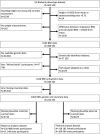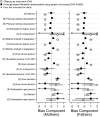Comparison of intergenerational instrumental variable analyses of body mass index and mortality in UK Biobank
- PMID: 35947758
- PMCID: PMC10114047
- DOI: 10.1093/ije/dyac159
Comparison of intergenerational instrumental variable analyses of body mass index and mortality in UK Biobank
Abstract
Background: An increasing proportion of people have a body mass index (BMI) classified as overweight or obese and published studies disagree whether this will be beneficial or detrimental to health. We applied and evaluated two intergenerational instrumental variable methods to estimate the average causal effect of BMI on mortality in a cohort with many deaths: the parents of UK Biobank participants.
Methods: In Cox regression models, parental BMI was instrumented by offspring BMI using an 'offspring as instrument' (OAI) estimation and by offspring BMI-related genetic variants in a 'proxy-genotype Mendelian randomization' (PGMR) estimation.
Results: Complete-case analyses were performed in parents of 233 361 UK Biobank participants with full phenotypic, genotypic and covariate data. The PGMR method suggested that higher BMI increased mortality with hazard ratios per kg/m2 of 1.02 (95% CI: 1.01, 1.04) for mothers and 1.04 (95% CI: 1.02, 1.05) for fathers. The OAI method gave considerably higher estimates, which varied according to the parent-offspring pairing between 1.08 (95% CI: 1.06, 1.10; mother-son) and 1.23 (95% CI: 1.16, 1.29; father-daughter).
Conclusion: Both methods supported a causal role of higher BMI increasing mortality, although caution is required regarding the immediate causal interpretation of these exact values. Evidence of instrument invalidity from measured covariates was limited for the OAI method and minimal for the PGMR method. The methods are complementary for interrogating the average putative causal effects because the biases are expected to differ between them.
Keywords: Mendelian randomization; UK Biobank; body mass index; instrumental variable; intergenerational; mortality; offspring as instrument; proxy genotype.
© The Author(s) 2022. Published by Oxford University Press on behalf of the International Epidemiological Association.
Conflict of interest statement
None declared.
Figures



References
-
- Rothman KJ. BMI-related errors in the measurement of obesity. Int J Obes 2008;32:S56–59. - PubMed
Publication types
MeSH terms
Grants and funding
LinkOut - more resources
Full Text Sources
Medical

